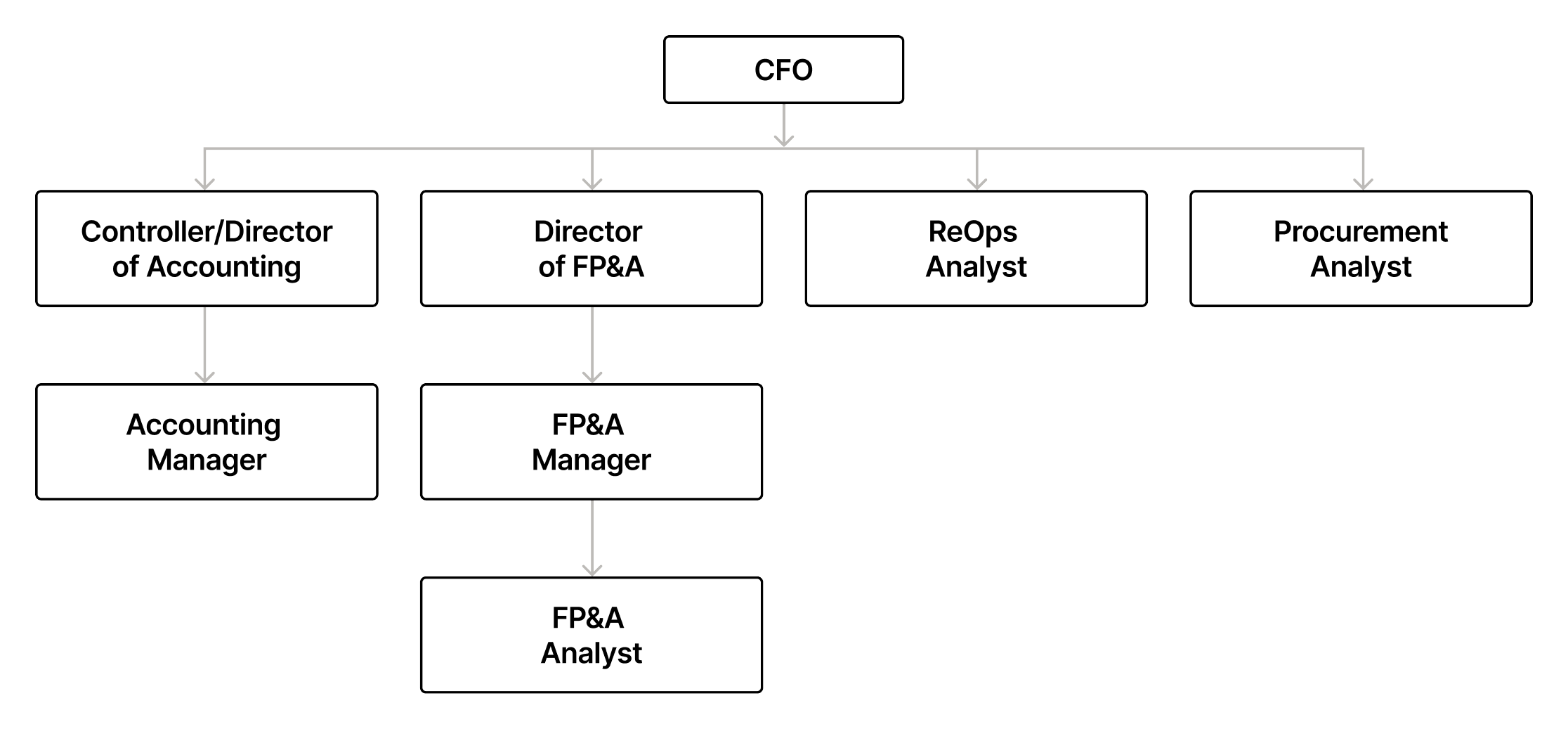Get FP&A best practices, research reports, and more delivered to your inbox.
TL;DR
- We analyzed 218 Y Combinator B2B companies (2015–2025) and 3,597 finance FTE records across 2,075 titles to see how modern finance orgs actually scale
- Most companies make their first full-time hire around 30–50 employees
- FP&A often shows up at the 51–250 employee mark
- Accounting headcount typically outpaces FP&A as companies scale
Why we made this
Most “how to scale your finance team” guides are one-size-fits-all. We wanted to build something more useful: a data-backed map of what teams actually do as headcount grows. Something that founders and CFOs could use to benchmark structure, timing, and tradeoffs.
Where the data comes from
- We analyzed 218 active B2B Y Combinator companies (Winter 2015–Spring 2025) and compiled 3,597 finance FTE records across 2,075 unique titles.
- We balanced four headcount buckets:
- 5–50
- 51–250
- 251–500
- 500+
- Our sample included companies with zero in-house finance hires (almost all of which were between 5-50 FTEs)
Finance team benchmarks by company size
Here’s the high-level view of finance team sizes across our dataset (includes Accounting, FP&A/Strategic Finance, and related titles under Finance).
As you can see, the finance-to-company ratio climbs steeply as companies grow from 5 to 250 employees, then tapers off as they approach 500. This is because, by this point, finance has most of its bases covered—further hires are dedicated to specialized roles.
When should a startup make its first finance hire?
Most companies make their first full-time finance hire late in the 30–50 FTE range. Before that, finance is typically founder-led or outsourced. Early hires tend to be a player-coach CFO/Head of Finance or a Controller/Accounting Manager who can own the close while leadership focuses on growth and runway.
Which finance roles appear at 50, 250, and 500+ employees?
5–50 FTEs: Founder-led finance
Most startups, especially at the earlier end of this stage, don’t have a formal finance team yet. The work is founder-led or handled by an outside firm. Just ~17% of companies in this band show an internal finance FTE in our dataset, and most are at the later end of the curve (30-50 employees).
51–250 FTEs: Structure emerges
The 50 employee mark is a key inflection point. Just about every company has at least one full-time finance or accounting person, and the mandate shifts from merely staying afloat to creating some structure.
What the org looks like
The first big change is around ownership. Work that previously lived with a single person or an external firm splits into defined lanes:
- Finance lead to set the reporting/forecasting cadence and own storytelling
- Controller to run a reliable month-end close
- FP&A to connect plan to reality and stand up BvA/board packs
Titles start to ladder (Analyst → Manager → Director), and “who does what by when” is written down rather than implied.
How the work changes
The day-to-day rhythm becomes more predictable: monthly close, budget vs actuals, and a board pack blueprint. This is also when core systems arrive:
- ERP and payroll to stabilize the close
- Basic BI tools that give leaders real-time visibility into KPIs
- A single source of truth that prevents confusion across departments
251–500 FTEs: Team layers start to form
By this point, finance is really flexing its muscles. Leadership has poured resources into the function, and they want to see more than just on-time closes and basic forecasts. They want finance to inform strategy and support decisions with credible, timely insights.
Every company in this band has an established team, and orgs typically expand to 8–15+ roles with a fully embedded CFO, layered FP&A, and formal Accounting leadership.
What the org looks like
- Full-time CFO
- Controller/Director of Accounting
- FP&A department: Director, Manager, Analyst
- Specialists: RevOps, Tax/Treasury, Procurement, etc.

As the finance organization starts to round out, the team can spend more time focusing on predicting what’s next while leaning on the accounting function to reconcile what happened.
How the work changes
- Finance owns the operating rhythm (rolling re-forecasts, scenario modeling, OKR support), and works shoulder-to-shoulder with GTM, Product, HR, and Ops
- Dashboards replace static decks
- Assumptions are shared instead of reinvented in silos
- Decisions happen faster because the numbers are trusted
500+ FTEs: Specialization throughout the function
Finance at this point is less a team unto itself and more of a network of teams. There are around 50 full-time finance staff on average at this size, with a deeper hierarchy spanning 4-5 levels.
What the org looks like
- CFO on the executive team
- VPs of FP&A, Accounting, Treasury, and Strategic Finance
- Each VP is supported by a Director, who has various Managers and Analysts under them
- FP&A is divided by scope:
- Corporate
- GTM
- Product
- Region/Product line
- Functions like Treasury, Tax, Procurement, Audit/Compliance, and RevOps have their own dedicated teams
How the work changes
The cadence is fully mature. You’re running monthly/quarterly forecasts, and scenario modeling is on tap to support every major decision. A unified planning system establishes a single source of truth and replaces siloed spreadsheets across business units. The stack is enterprise-grade and automated.
More than just supporting the business, finance becomes its connective tissue—balancing long-term strategic modeling with real-time operational execution so growth is predictable and decisions are fast.
Accounting versus FP&A: Why Accounting outgrows Finance at scale
As companies scale, accounting roles increasingly outnumber FP&A. Why?
- Recurring operational load: invoices, payroll, consolidations, global entities, and compliance grow exponentially, not linearly.
- Regulatory rigor: audits, SOX, and country-specific rules force specialization (RevRec, payroll, AP/AR, fixed assets).
- The close drives hiring: the close can’t slip. FP&A can pause, Accounting can’t.
Accounting is the muscle; strategic finance is the brain—and both scale differently.
.png)
Get the full breakdown
What we’ve covered here is just a slice of the data. The full eBook includes:
- Role-by-role benchmarks across CFO, Controller, FP&A, and Finance Ops
- Headcount ranges for both early and late ends of each stage
- Guidance on team layering, tooling, and org complexity
If you're scaling your finance team—or just want to know how yours stacks up—check out the full report.
Get FP&A best practices, research reports, and more delivered to your inbox.












